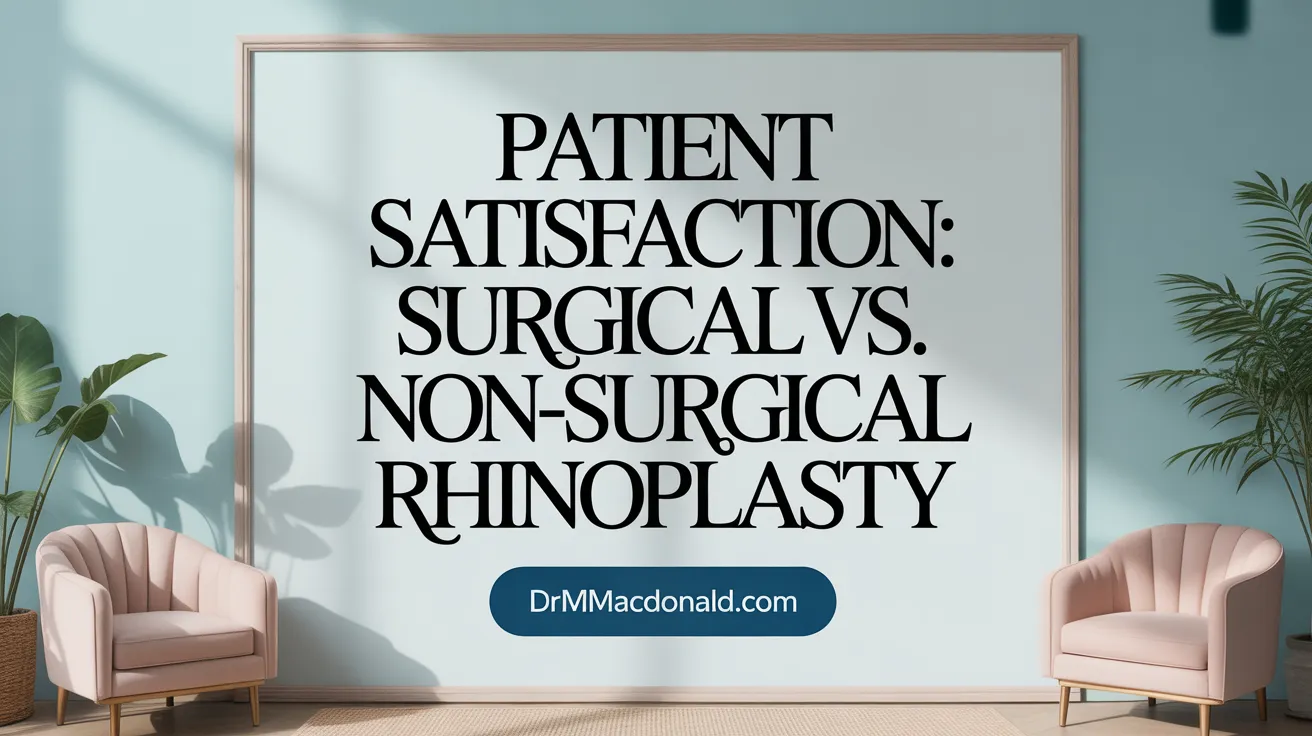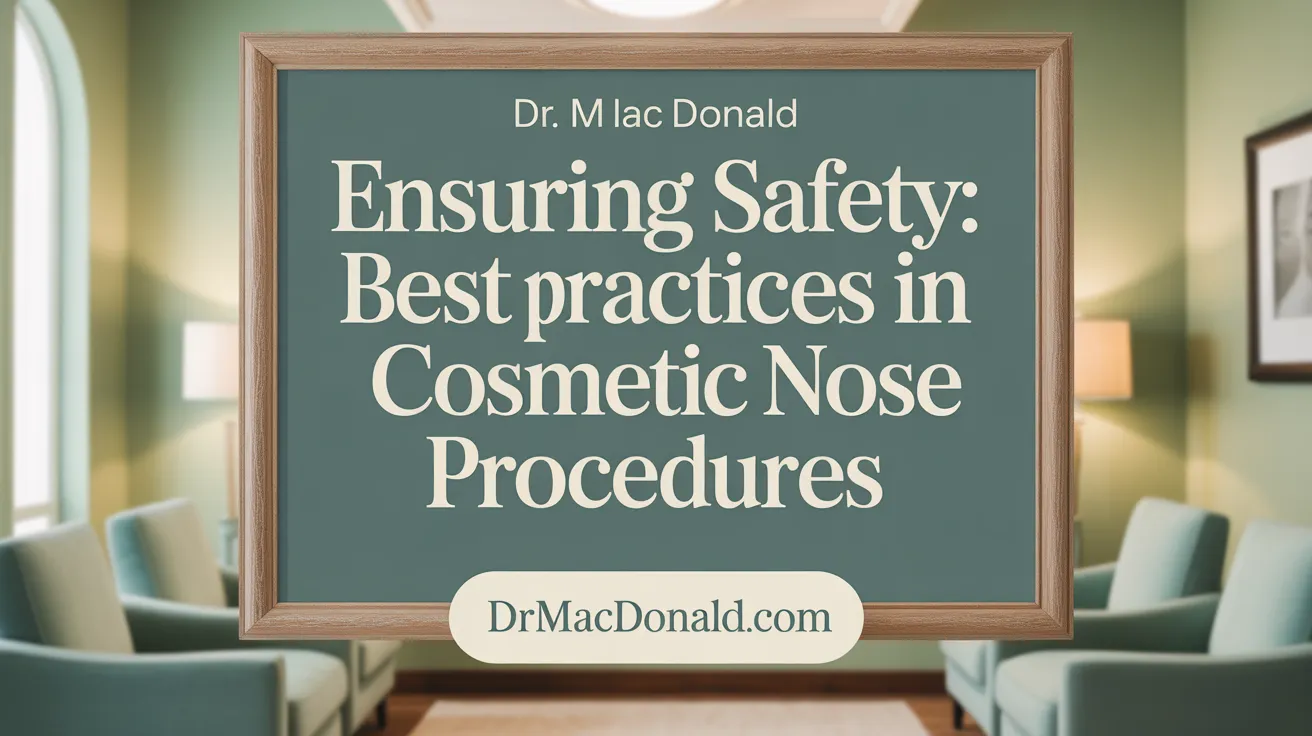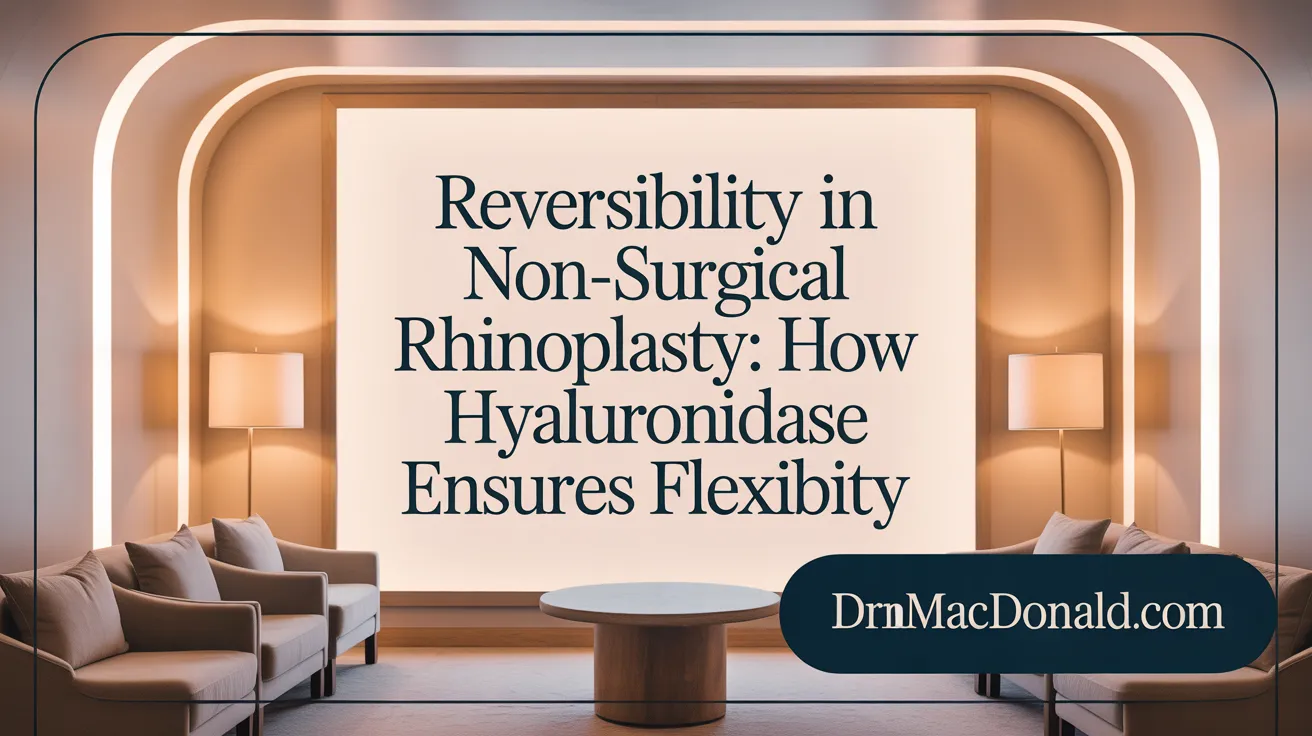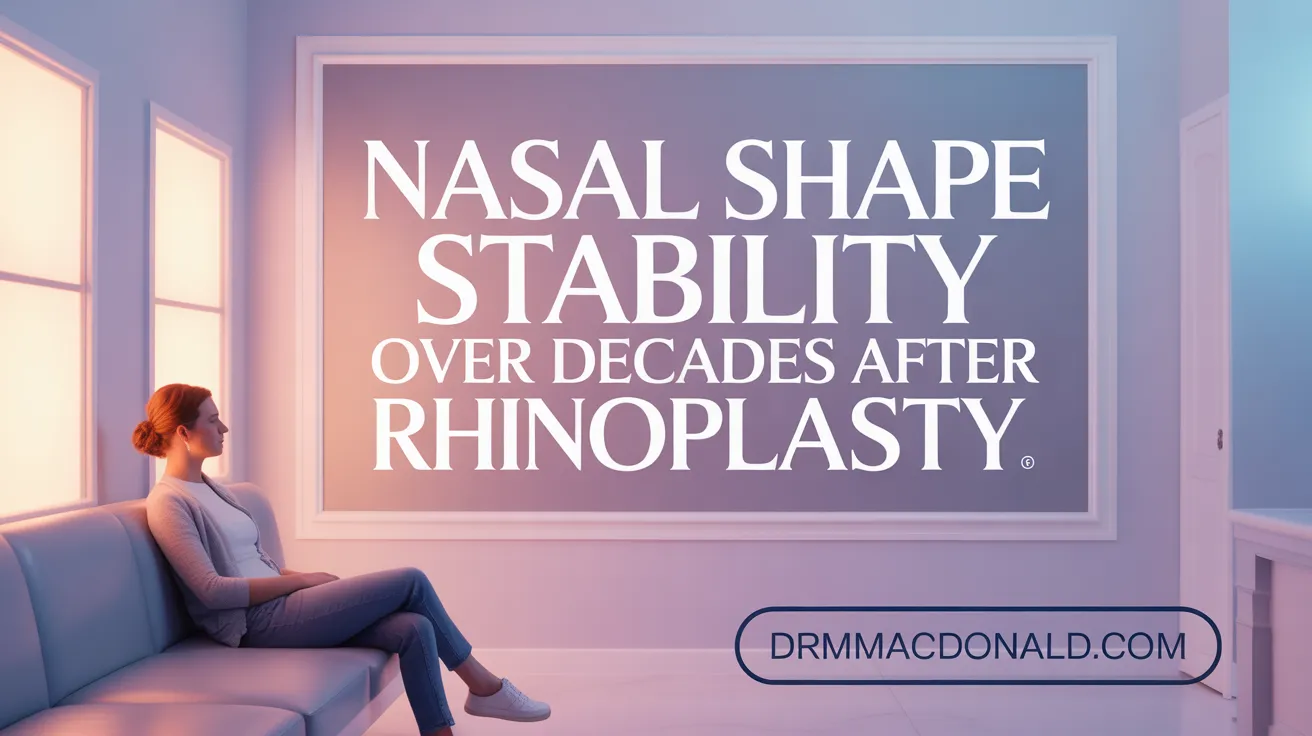Understanding the Statistical Landscape of Nose Reshaping Procedures
Nose reshaping is a popular cosmetic choice, with options ranging from traditional surgical rhinoplasty to minimally invasive non-surgical treatments like liquid rhinoplasty. This article delves into 21 compelling statistics that illustrate the differences in results, satisfaction, risks, costs, and more between these two approaches. These data-driven insights aim to equip you with a clearer understanding for making informed decisions about your nose enhancement options.
Nasal Reconstructive Procedures: Surgical vs Non-Surgical
- Between 2019 and 2022, rhinoplasty procedures increased by 37% in the U.S., with a 70% surge in minimally invasive dermal filler treatments.
- Patient satisfaction rates are high for both, with approximately 93% satisfied with non-surgical rhinoplasty, and 85-90% success for surgical rhinoplasty.
- Surgical rhinoplasty has a success rate of around 85-90%, with revision needed in about 10-15% of cases.
- Surgical rhinoplasty takes about one hour, while liquid rhinoplasty lasts around 15-30 minutes, showcasing its convenience.
- Surgical recovery spans 1-2 weeks, whereas non-surgical procedures allow immediate return to daily activities.
- Cost-wise, surgical rhinoplasty starts at approximately $6,000, while liquid rhinoplasty costs $600-$1,500 per treatment session.
- Results from surgical rhinoplasty are permanent, while fillers typically last 6-18 months and require maintenance.
- Surgical rhinoplasty provides a lifelong, permanent solution, compared to temporary results in non-surgical options, which need periodic touch-ups.
- Surgical rhinoplasty is suitable for significant structural corrections (e.g., deviations), while non-surgical procedures address minor aesthetic issues like dorsal humps.
- Complication risks in non-surgical rhinoplasty are low, with skin necrosis (0.06%) and vascular occlusion (0.5%), requiring proper safety measures.
1. Popularity Surge: Growth in Procedures Between 2019 and 2022
Between 2019 and 2022, the number of rhinoplasty surgeries in the U.S. increased by 37%, reflecting a rising demand for nose reshaping procedures. During the same period, minimally invasive dermal filler treatments surged by 70%, totaling nearly 4.9 million procedures, indicating a strong preference for non-surgical options. This trend highlights the growing popularity of quick, less invasive methods like liquid rhinoplasty for minor aesthetic enhancements.
2. Patient Satisfaction Rates: Surgical vs Non-Surgical Rhinoplasty
 Studies show high satisfaction with both procedures. Approximately 93% of patients report satisfaction with non-surgical rhinoplasty, valuing its quick results and minimal downtime. Surgical rhinoplasty also boasts a success rate of around 85-90%, appealing for permanent, more extensive changes. While surgical options offer long-lasting results, many patients prefer non-invasive fillers for minor corrections with immediate effects and fewer risks.
Studies show high satisfaction with both procedures. Approximately 93% of patients report satisfaction with non-surgical rhinoplasty, valuing its quick results and minimal downtime. Surgical rhinoplasty also boasts a success rate of around 85-90%, appealing for permanent, more extensive changes. While surgical options offer long-lasting results, many patients prefer non-invasive fillers for minor corrections with immediate effects and fewer risks.
3. Success Rates of Surgical Rhinoplasty
Surgical rhinoplasty boasts a high success rate, typically around 85-90%. However, some patients may require revision procedures, which occur in about 10-15% of cases. These revisions aim to fine-tune the results or address complications, ensuring patient satisfaction and optimal outcomes.
4. Average Procedure Time Comparison
Surgical rhinoplasty typically takes about one hour to perform in a medical setting, often requiring general anesthesia and a longer recovery period. In contrast, liquid rhinoplasty sessions are much quicker, generally lasting around 15 to 30 minutes under local anesthesia or numbing cream. This significant difference highlights the convenience of non-surgical options for minor aesthetic adjustments.
5. Recovery Time Differences
Surgical rhinoplasty typically requires about one to two weeks for initial recovery, with swelling and bruising gradually subsiding over several months. In contrast, liquid rhinoplasty offers minimal downtime, often allowing patients to return to daily activities immediately after the procedure. The quick recovery process makes non-surgical options an attractive choice for those seeking minor cosmetic adjustments without extended recovery periods.
6. Costs Comparison: Surgical Rhinoplasty vs Liquid Rhinoplasty
Traditional surgical rhinoplasty generally starts at around $6,000, depending on location and surgeon expertise. In contrast, non-surgical filler procedures, or liquid rhinoplasty, typically cost between $600 and $1,500 per session, often requiring multiple treatments for maintenance, making it a more affordable and flexible option.
7. Longevity of Results: Permanent vs Temporary
Surgical rhinoplasty typically provides permanent results, with changes lasting a lifetime after healing. In contrast, non-surgical fillers like hyaluronic acid usually last between 6 to 18 months, requiring periodic touch-ups to maintain the desired shape. The choice depends on whether a lasting or temporary modification better suits the patient's goals.
8. Frequency of Maintenance: One-Time Surgery vs Repeat Treatments
Surgical rhinoplasty offers a long-lasting, permanent solution, typically not requiring further procedures once healed. Conversely, non-surgical rhinoplasty with hyaluronic acid fillers is temporary; most patients need periodic touch-ups every 9 to 18 months to maintain their desired appearance. Regular maintenance for liquid rhinoplasty ensures consistent results, whereas surgical results are generally permanent, reducing the need for repetitive treatments.
9. Types of Nasal Concerns Addressed by Each Procedure
Surgical rhinoplasty is suitable for significant structural corrections, such as dorsal humps or deviations, providing permanent and extensive changes.
In contrast, non-surgical fillers excel at minor aesthetic improvements, effectively camouflaging irregularities, softening humps, or lifting drooping tips temporarily.
| Concern Type | Procedure | Nature of Changes | Additional Notes |
|---|---|---|---|
| Structural correction | Surgical rhinoplasty | Permanent bone and cartilage reshaping | Addresses large deviations and deformities |
| Minor aesthetic issues | Non-surgical rhinoplasty | Temporary smoothing and contouring | Ideal for subtle adjustments |
Choosing the right procedure depends on the specific nasal concern, with surgery preferred for structural alterations and fillers for minor cosmetic tweaks.
10. Complication Rates in Non-Surgical Rhinoplasty
The complication rates in non-surgical rhinoplasty are generally low. Skin necrosis occurs in about 0.06% of cases, often manageable if detected early. Vascular occlusion, a serious risk, appears in approximately 0.5% of procedures but can typically be resolved with hyaluronidase injections. Infection rates are minimal, reported at around 0.04%, and usually respond to prompt treatment. Overall, with proper technique and careful patient assessment, non-surgical rhinoplasty remains a safe option for minor nasal enhancements.
11. Complications and Risks in Surgical Rhinoplasty
Surgical rhinoplasty carries certain risks, with infection and bleeding occurring at low rates. Incidences of scarring are usually minimal due to the precise techniques used. Revision surgeries are sometimes necessary if the desired outcome is not achieved or complications arise. Overall, these risks can be mitigated through expert surgical care.
12. Pain and Discomfort Levels: Comparing Patient Experiences
Patients undergoing non-surgical rhinoplasty report a low average pain score of about 2 out of 10, indicating minimal discomfort during the procedure. This quick, minimally invasive treatment typically involves little to no pain, and patients can often return to daily activities immediately.
In contrast, recovery from traditional surgical rhinoplasty can involve significant discomfort. Swelling, bruising, and soreness are common in the initial days following surgery. While pain varies from person to person, the recovery phase often requires pain management, and patients usually need about one to two weeks off work. Full comfort and stabilization of results may take several months.
This comparison highlights that non-surgical rhinoplasty offers a much more comfortable and faster recovery experience for patients seeking minor aesthetic improvements.
13. Procedural Techniques: Injection Volume vs Surgical Incisions
During non-surgical rhinoplasty, the average volume of hyaluronic acid fillers injected is approximately 0.72 mL, aiming for balanced nasal contouring and subtle corrections. This minimal volume typically provides immediate, natural-looking results with less trauma and downtime.
In contrast, surgical rhinoplasty involves precise incisions inside or outside the nose—often across the columella (the tissue between the nostrils) or within the nostrils themselves. Surgeons then restructure the nasal bones, cartilage, and soft tissue to achieve permanent changes. These procedures may include removing a dorsal hump, correcting deviations, or refining the nasal tip, using techniques such as osteotomies (bone breaking) and cartilage reshaping.
Both approaches require different technical skills and planning, with injection techniques focusing on accurate placement in the subdermal or supraperiosteal plane, while surgical methods demand careful dissection and structural modification.
14. Demographics: Age and Gender Trends in Non-Surgical Rhinoplasty
Most patients opting for non-surgical rhinoplasty are young adults, with the average age around 27 years. The primary age group is between 25-34 years old, which accounts for about half of the patients. Females tend to seek these procedures more frequently than males, reflecting a gender distribution skewed towards women.
15. Patient Concerns Driving Non-Surgical Nose Treatments
Patients seeking non-surgical rhinoplasty typically have minor nasal imperfections. The most common aesthetic complaints include dorsal humps, drooping nasal tips, lack of definition, frontal asymmetry, and bulbous tips.
A recent study involving 5,000 procedures found that 44% of patients sought correction for dorsal humps, making it the most addressed concern. Drooping tips accounted for 15%, while issues like lack of nasal definition were reported by 9%. Other complaints included asymmetry (7%) and bulbous tips (6%).
This breakdown highlights that the majority of patients opting for non-surgical treatments aim to subtly improve and balance their nose profile without extensive surgery. Many choose this route for its quick results, low risks, and reversibility.
Most Common Aesthetic Complaints
- Dorsal hump
- Drooping tip
- Lack of definition
- Asymmetry
- Bulbous tip
Percentage Breakdown of Issues Addressed
| Concern | Percentage | Details |
|---|---|---|
| Dorsal hump | 44% | Most common concern for contour smoothing |
| Drooping nasal tip | 15% | Heightening or lifting the nasal tip |
| Lack of definition | 9% | Refining nasal bridge |
| Frontal asymmetry | 7% | Improving facial symmetry |
| Bulbous tip | 6% | Softening or refining the nasal tip |
This data underscores the popularity of non-surgical rhinoplasty for addressing such minor imperfections efficiently. Patients appreciate the quick, reversible results that can be achieved without anesthesia or recovery downtime.
16. Injection Safety Practices Minimizing Non-Surgical Risks
 Ensuring safety during non-surgical rhinoplasty involves specific injection techniques. Practitioners often use aspiration before injecting filler to reduce the risk of vascular occlusion. The use of hyaluronic acid fillers is common because they are reversible; if complications occur, hyaluronidase can dissolve the filler swiftly. These practices are vital for minimizing risks like skin necrosis or vascular complications, making the procedure safer for patients.
Ensuring safety during non-surgical rhinoplasty involves specific injection techniques. Practitioners often use aspiration before injecting filler to reduce the risk of vascular occlusion. The use of hyaluronic acid fillers is common because they are reversible; if complications occur, hyaluronidase can dissolve the filler swiftly. These practices are vital for minimizing risks like skin necrosis or vascular complications, making the procedure safer for patients.
17. Impact of External Factors on Non-Surgical Rhinoplasty Results
Effect of heavy glasses on filler displacement
Patients who frequently wear heavy glasses may risk displacing the nasal fillers, especially on the bridge of the nose. This pressure can cause temporary shifts in the filler position, affecting the aesthetic results.
Variations in filler longevity
The duration of results after non-surgical rhinoplasty varies among individuals due to factors like metabolic rate, skin type, and lifestyle. Typically, hyaluronic acid fillers last between 6 to 18 months, with some patients experiencing effects up to two years.
Additional external influences
Environmental factors such as sun exposure, smoking, and skin care routines can also impact filler longevity and the overall success of the procedure. Proper post-procedure care and avoiding excessive pressure or trauma to the nose help maintain desired results longer.
18. Reversibility: Ability to Undo Non-Surgical Rhinoplasty
 Hyaluronidase enzyme is used to dissolve hyaluronic acid fillers in cases where reversal of non-surgical rhinoplasty is desired. This provides safety and control over the procedure, allowing practitioners to promptly address complications or adjust results if needed.
Hyaluronidase enzyme is used to dissolve hyaluronic acid fillers in cases where reversal of non-surgical rhinoplasty is desired. This provides safety and control over the procedure, allowing practitioners to promptly address complications or adjust results if needed.
19. Structural Changes Possible Only with Surgery
 Traditional rhinoplasty is capable of making significant structural changes to the nose that non-surgical methods cannot achieve. It allows doctors to reduce the overall size of the nose, correct major deviations, and address breathing issues. These extensive modifications involve reshaping bone and cartilage, which is beyond the scope of injectable fillers used in non-surgical rhinoplasty. Therefore, for those needing major adjustments or functional improvements, surgery remains the most effective option.
Traditional rhinoplasty is capable of making significant structural changes to the nose that non-surgical methods cannot achieve. It allows doctors to reduce the overall size of the nose, correct major deviations, and address breathing issues. These extensive modifications involve reshaping bone and cartilage, which is beyond the scope of injectable fillers used in non-surgical rhinoplasty. Therefore, for those needing major adjustments or functional improvements, surgery remains the most effective option.
20. Patient Return to Daily Activities Post-Procedure
Patients who undergo surgical rhinoplasty typically need about 1 to 2 weeks off work due to swelling, bruising, and recovery requirements. In contrast, those who choose non-surgical liquid rhinoplasty can usually return to their daily activities immediately or within the same day, thanks to its minimal invasiveness and lack of significant downtime.
21. Long-Term Outcomes: Structural Stability 20 Years After Surgery
 Surgical rhinoplasty typically offers lasting structural changes, with many results remaining stable for decades. Factors such as aging, skin elasticity, and cartilage resilience influence long-term nasal shape. While most patients experience durable outcomes, some may notice minor shifts over time, highlighting the importance of proper initial technique and follow-up care.
Surgical rhinoplasty typically offers lasting structural changes, with many results remaining stable for decades. Factors such as aging, skin elasticity, and cartilage resilience influence long-term nasal shape. While most patients experience durable outcomes, some may notice minor shifts over time, highlighting the importance of proper initial technique and follow-up care.
Key Differences Between Surgical and Non-Surgical Rhinoplasty
Procedure types
Surgical rhinoplasty involves a surgical procedure where incisions are made to reshape the nose’s bone and cartilage. This allows for significant and permanent structural changes, correcting deformities, correcting deviated septums, or reducing size. It often requires general anesthesia and an operating room setting.
Non-surgical rhinoplasty, also called liquid rhinoplasty, uses injectable dermal fillers such as hyaluronic acid. It’s a minimally invasive procedure performed in-office with local anesthesia or numbing cream. The focus is on subtle aesthetic changes like smoothing dorsal bumps or refining nasal tips.
Permanency of results
The results from surgical rhinoplasty are permanent and long-lasting, provided there are no complications or future revisions. Once healed, the structural modifications last a lifetime.
In contrast, non-surgical rhinoplasty offers temporary results, typically lasting between 6 to 18 months. The fillers gradually dissolve and need re-injection to maintain the desired look.
Recovery and risks
Recovery from surgical rhinoplasty takes about 1 to 2 weeks, with swelling, bruising, and discomfort possibly lasting longer. There are risks of bleeding, infection, scarring, and anesthesia-related complications.
Non-surgical rhinoplasty involves minimal downtime. Patients often return to normal activities immediately after the procedure. Risks include swelling, bruising, rare vascular occlusions, skin necrosis, or allergic reactions. Since it’s reversible with hyaluronidase, unwanted results can often be corrected.
Cost brackets
Surgical rhinoplasty generally costs around £5000, reflecting its complexity, anesthesia, and longer recovery. Additional expenses may include anesthesia fees and post-op care.
Non-surgical options are more affordable, ranging from about £450 to £1100 per session. Multiple sessions might be needed for ongoing adjustments, adding to long-term costs.
Suitability
Surgical rhinoplasty is suitable for individuals seeking permanent, significant alterations to address both aesthetic and functional issues like breathing problems.
Non-surgical rhinoplasty is best suited for minor imperfections such as dorsal bumps, asymmetry, or drooping tips, especially for those who prefer a quick, non-invasive approach and are comfortable with temporary results.
Ultimately, the decision depends on individual goals, with surgery favored for lasting structural change and non-surgical methods chosen for minor, temporary refinements.
Comparing Effectiveness and Satisfaction Rates
Surgical rhinoplasty is renowned for its high success rates, typically achieving lasting, significant improvements for a wide range of nasal deformities. This procedure boasts an effectiveness rate of approximately 85-90%, with many patients reporting satisfaction levels between 80-85%. Since it involves altering bone, cartilage, and soft tissues, the results are permanent, making it suitable for those seeking substantial and long-term changes.
In contrast, non-surgical rhinoplasty, often referred to as liquid rhinoplasty, uses hyaluronic acid fillers to modify the nose's appearance temporarily. Surveys indicate satisfaction rates exceeding 93%, driven by quick results and minimal discomfort. The procedure usually takes about 30 minutes, and most patients find the immediate outcomes satisfactory. However, these results last around 9-12 months and require repeat treatments to maintain the appearance.
The choice between the two depends largely on the patient's goals. Surgery offers permanent and dramatic correction, ideal for severe deformities or structural issues. Meanwhile, non-surgical options are favored for minor adjustments, offering a reversible and less invasive alternative. For those prioritizing long-term solutions, surgical rhinoplasty remains the preferred option, whereas non-surgical procedures suit individuals seeking temporary enhancement or testing potential changes before opting for surgery.
| Aspect | Surgical Rhinoplasty | Non-Surgical Rhinoplasty | Details |
|---|---|---|---|
| Success Rate | 85-90% | Over 93% | Based on patient reports and clinical studies |
| Satisfaction | 80-85% | >93% | Patient-reported satisfaction levels |
| Duration of Results | Permanent | 9-12 months | Reversible through touch-ups |
| Recovery Time | 1-2 weeks | Immediate return | Downtime varies greatly |
| Risks | Infection, scars, anesthesia complications | Vascular occlusion, swelling | Safety profiles differ |
Overall, understanding these differences helps patients and doctors choose the most suitable procedure—balancing long-term goals with temporary preferences.
Safety, Risks, and Complications Compared
What are the common safety concerns, risks, and complications associated with surgical and non-surgical nose enhancements?
Both surgical and non-surgical rhinoplasty procedures involve certain safety considerations and potential risks, which are important for prospective patients to understand.
Surgical rhinoplasty, being an invasive procedure, carries risks such as infection, excessive bleeding, visible scarring, and complications related to anesthesia. There is also a possibility of irregularities in the nose shape post-surgery, needing revision procedures. These risks highlight the importance of expert surgical care and thorough pre-and post-operative management.
On the other hand, non-surgical rhinoplasty, which uses dermal fillers like hyaluronic acid, generally has a lower risk profile but is not without potential complications. Common issues include swelling, bruising, and transient discomfort at the injection site. More serious, though rare, complications involve vascular occlusion, skin necrosis, and even vision loss if an injected filler inadvertently blocks a blood vessel supplying the eye.
Most adverse effects from non-surgical procedures are mild and resolve quickly, with serious complications estimated at around 2.5%. Proper technique and experience significantly reduce these risks. Vascular problems are particularly rare but require immediate medical attention.
Importance of specialist care
Given these risks, the expertise of the practitioner performing either procedure is crucial. An experienced surgeon or aesthetic injector minimizes the chances of complications through precise techniques, awareness of facial anatomy, and adherence to safety protocols. Patients should seek practitioners who are specifically trained and certified in their respective procedures to ensure safety and optimal outcomes.
Suitability Factors for Surgical vs Non-Surgical Procedures
What factors influence the suitability of a patient for surgical versus non-surgical nose procedures?
Choosing between surgical and non-surgical rhinoplasty depends on several important factors related to the individual's nasal structure, aesthetic goals, and overall health.
Non-surgical options, especially hyaluronic acid (HA) filler-based rhinoplasty, are ideal for those seeking minor, subtle changes such as smoothing dorsal irregularities, enhancing nasal symmetry, or lifting the nasal tip. These procedures offer immediate results, are minimally invasive, and are preferred by patients wanting to avoid the risks and downtime associated with surgery.
On the other hand, surgical rhinoplasty is better suited for patients desiring significant, permanent modifications. It can address complex issues like large dorsal humps, nasal deviations, or tip rotation that cannot be achieved with fillers alone. Surgery is also the choice for correcting breathing problems or structural deformities.
Patient preferences regarding recovery time, the permanence of results, and risk tolerance are crucial. Non-surgical procedures often involve temporary outcomes lasting 6 to 18 months and may require repeat treatments, while surgical rhinoplasty offers lifelong changes.
Furthermore, the complexity of the nasal issue influences suitability. Minor aesthetic concerns typically respond well to non-invasive filler treatments, whereas major deformities generally necessitate surgical intervention.
It is essential to consult with a qualified healthcare professional to evaluate nasal anatomy, discuss goals, and determine the most appropriate approach based on these factors. Proper assessment ensures safe and effective results tailored to each individual’s needs.
Cost and Recovery Time Differences Explored
When comparing the expenses and healing periods of surgical rhinoplasty to non-surgical alternatives like liquid rhinoplasty, notable differences become evident. Surgical rhinoplasty is generally more costly, often starting from around $6,000, due to the complexity of the procedure, longer operative time, the need for anesthesia, and extended post-operative care. Recovery for traditional rhinoplasty can span about one to two weeks for initial healing, with swelling, bruising, and activity restrictions lasting several weeks to months. Complete resolution of swelling and final results might take up to a year.
In contrast, non-surgical rhinoplasty, primarily using hyaluronic acid fillers, is significantly less expensive, typically costing between $600 and $1,500 per session. It is a quick procedure, generally taking 15 to 30 minutes, with patients able to resume normal activities immediately afterward. The side effects are usually mild, including redness or swelling, which resolve within a few days. The effects are temporary, lasting from six to twelve months, and may require repeat treatments to maintain the results.
The key difference lies in the permanence and invasiveness: surgical options provide permanent, substantial structural changes but require longer recovery, while nonsurgical methods are ideal for minor, temporary adjustments with minimal downtime. Choosing between them depends on individual goals, budget, and willingness to undergo surgery.
| Aspect | Surgical Rhinoplasty | Non-Surgical Rhinoplasty | Additional Considerations |
|---|---|---|---|
| Cost | From approximately $6,000 | $600 - $1,500 per session | Surgical costs are higher but permanent; fillers are less costly but temporary |
| Procedure Time | About 1-2 hours | 15-30 minutes | Longer procedures involve anesthesia and recovery |
| Recovery Time | 1-2 weeks for initial; up to a year for full swelling resolution | Few days for swelling; no significant downtime | Surgical recovery requires activity restrictions and follow-up |
| Results | Permanent, significant structural and aesthetic changes | Temporary, subtle aesthetic adjustments | Surgical reshapes bone and cartilage; fillers only contour soft tissues |
| Long-term Maintenance | No re-treatment typically needed | Repeated sessions needed to sustain results | |
| Risks | Infection, scars, anesthesia issues | Vascular occlusion, swelling, infection | Both carry risks, mitigated with expert care |
Overall, non-surgical rhinoplasty offers a quick, affordable, and reversible solution for minor facial aesthetic concerns, fitting well for patients seeking quick results with little recovery. However, it cannot replace surgical rhinoplasty for those requiring extensive or permanent correction. Each option's suitability depends on individual preferences, health, and expectations.
Typical Duration of Liquid Rhinoplasty Results
The effects of liquid rhinoplasty, primarily performed with hyaluronic acid-based dermal fillers, generally last between 6 to 18 months. Most patients find that their results remain visible for about 9 to 12 months before the effects gradually fade.
The longevity of these outcomes can vary widely depending on individual factors such as metabolism, skin type, and the specific type of filler used. Hyaluronic acid fillers are resorbable, which means the body slowly absorbs the material over time, necessitating repeat treatments to maintain the desired shape.
Some patients may experience longer-lasting results, up to 18 months, especially if they follow post-procedural care and avoid behaviors that might accelerate filler breakdown.
It is important to note that while some procedural variations like fat transfer can offer permanent results if the patient maintains a stable weight, standard liquid rhinoplasty with fillers is usually temporary. Regular touch-up sessions are necessary for ongoing results, making this an appealing option for those seeking minor, reversible changes without surgical commitment.
Nasal Shape Stability 20 Years Post-Surgery
 Twenty years after undergoing surgical rhinoplasty, many patients notice that the changes made to the nose's bony and cartilage structures remain largely stable. The initial modifications typically provide permanent results, especially when reinforced with sturdy cartilage grafts and precise surgical techniques.
Twenty years after undergoing surgical rhinoplasty, many patients notice that the changes made to the nose's bony and cartilage structures remain largely stable. The initial modifications typically provide permanent results, especially when reinforced with sturdy cartilage grafts and precise surgical techniques.
However, it's important to recognize the natural aging process influences nasal appearance over time. As the skin loses elasticity and tissues atrophy, subtle shifts can occur in the nasal shape. The cartilage may gradually shift or weaken, leading to minor contour changes, such as a slight drooping of the nasal tip or alterations in nasal height.
Reconstructive and reinforcement techniques used during surgery, such as cartilage grafts, help maintain the nose's structural integrity over decades and lessen the risk of deformities or collapse. Nevertheless, external factors like sun exposure, smoking, nasal injuries, or subsequent procedures can impact the long-term appearance.
Overall, most patients enjoy lasting aesthetic improvements and benefit from high satisfaction levels. Some minor contour adjustments may happen naturally with age, but these are generally manageable and do not significantly diminish the initial surgical results.
Understanding these long-term effects can prepare patients for future changes and aid in planning possible revision procedures if desired. This emphasizes the importance of a skilled surgeon and proper postoperative care to ensure durable, youthful nasal harmony for years to come.
Choosing the Right Nose Reshaping Approach: Insights from the Numbers
This comprehensive statistical overview highlights critical differences between surgical rhinoplasty and non-surgical alternatives like liquid rhinoplasty. Surgery remains the choice for individuals seeking permanent, structural, and functional changes, offering high success and satisfaction despite longer recovery and higher costs. Meanwhile, non-surgical rhinoplasty appeals to those desiring quick, reversible, and minor aesthetic refinements, with impressive satisfaction rates and minimal downtime but temporary results. Understanding these nuanced statistical comparisons empowers patients to align their goals, risk tolerance, and budget with the most suitable procedure. Ultimately, expert consultation remains essential to navigate these options safely and effectively for optimal nose enhancement outcomes.
References
- Non-surgical Rhinoplasty (NSR): A Systematic Review of Its ...
- Liquid Rhinoplasty: A Non-Surgical Option to Sculpt a Stunning Nose
- What We Learned After 5,000 Nonsurgical Rhinoplasties | ASPS
- The Popularity of Liquid Rhinoplasty - Tampa - ImageLift
- Non-Surgical Rhinoplasty Vs. Traditional Nose Job | Dr. Margoles
- Liquid vs Surgical Rhinoplasty Explained - The Naderi Center
- Surgical Rhinoplasty vs Non Surgical Nose Job - Kensington Medical
- Comparing Non-Surgical and Traditional Rhinoplasty
- [PDF] 2023 Plastic Surgery Statistics Report
- Liquid vs. Surgical Rhinoplasty - Houston - Sanaz Harirchian, M.D
